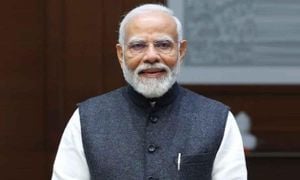With the 2024 U.S. Presidential Election rapidly approaching, the race between Vice President Kamala Harris and former President Donald Trump is shaping up to be incredibly competitive, particularly in several key swing states. Recent polls indicate the candidates are neck and neck, with party strategies and voter sentiments shifting daily.
According to multiple polls conducted by organizations such as the UMass Lowell’s Center for Public Opinion and YouGov, Harris has forged a slight but significant lead over Trump in swing states like Michigan and Pennsylvania. Specifically, Harrison's numbers sit at about 48% compared to Trump's 46% within Pennsylvania, according to the UMass Lowell poll. These results reflect the tight race as both candidates seek to secure their foothold just weeks before Election Day.
Political analysts point out the importance of these battleground states. Rodrigo Castro Cornejo, assistant professor at UMass Lowell and associate director of the polling center, noted, "The presidential race remains very close in Pennsylvania with the coming weeks being pivotal for both campaigns," highlighting the urgency for both campaigns to mobilize their bases.
Similar patterns are found across Michigan, where Harris holds about 48% and Trump around 43%, according to the latest polls showing Harris enjoying modest gains. Cornejo emphasized, "For a swing state, this margin is good news for the vice president's campaign," noting the urgency for Trump’s campaign to reverse negative perceptions among Michigan voters.
While Harris seems to be performing well domestically, polling data from Georgia presents mixed results. Harris appears to lead with 51% against Trump's 48%, showcasing her growing support among voters. Conversely, other states like Arizona present challenges; Trump maintains vaunted support with 51% versus Harris's 48%.
Overall, the election is being framed as one of the closest contests we’ve seen. This sentiment resonates with political data indicating the potential for drastic changes as each candidate rolls out their campaigns leading up to November. The Emerson/Pollara poll underlined the ties and leads, stating both candidates are effectively competing for every last voter.
The stakes are undeniably high as both political camps reflect on their positions. Harris will likely continue to lean on voter mobilization strategies and potentially focus on issues such as economic recovery and social justice to sway undecided voters, particularly those targeted through grassroots campaigns. On the other hand, Trump may seek to galvanize his base through rhetoric around immigration and security, hoping to dominate discussions on national safety.
Recent polling aggregates suggest Harris leads by approximately two points nationally, but with much of the battleground states remaining too close to call, both candidates must focus on getting their voters to the ballot boxes. This dynamic indicates likely shifts in campaign strategies as the race progresses, with each side analyzing voter sentiment, fundraising reports, and debate performances.
Heading toward the home stretch, Harris’s campaign aims to boost efforts to engage younger, non-white voters, demographics where she is currently gaining traction. According to data from the New York Times, she has secured unprecedented support among Black voters, showcasing more than 84% backing among this key group.
At the same time, Trump's campaign has made it clear they're not backing down. They plan to highlight Harris’s association with Biden's policies which have come under scrutiny during the past few years. This approach may help them regain lost ground with certain voter blocs who were previously supportive of their initiatives during the last election.
The coming weeks pose numerous challenges as candidates grapple with fluctuated favorability ratings. Polls confirm Trump is viewed unfavorably by about 56% of respondents, contributing to what appears to be greater sympathy for Harris. Current perceptions may compel Trump to recalibrate his campaign messaging significantly.
Turning to other battleground states, polls show Wisconsin and North Carolina offer little clarity, as candidates vie for control with the numbers tied at 50% across multiple surveys. According to recent updates from FiveThirtyEight and RealClearPolitics, the competition is not just statistical but highly emotional, reflecting the passionate voter bases on both sides.
While the calendar inches closer to November, the energy of this race invokes the possibility of unprecedented turnout with voters eager to shape the future leadership of the nation. Each sidewalk rally, digital ad, and town hall serves as stakes driving the push for decisive victories on either side.
With the cacophony of strategies, surprises, and predictions, the 2024 election could be regarded as one for the books. Attention now turns not only to who can rally the most support but also to who can maintain it as the clock ticks down. Political analysts warn both campaigns will need to focus on effective messaging delivered through diverse channels to overcome competing narratives.



